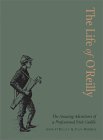The Life of O’Reilly: The Amusing Adventures of a Professional Irish Caddie
A while ago I reviewed Caddie Sense, by PGA caddie Michael Carrick. Much as I wanted to like that book, unfortunately it was something of a disappointment.
I think I expected a bit more insight into the life and work of a professional caddie than Carrick provided.
Equally unfortunately, The Life of O’Reilly falls into the same category.
John O’Reilly was a long-time caddie on the European PGA Tour, and in recent years one of the senior statesmen among the looper contingent. Over his 25-year career, he worked primarily for Peter Townsend, Des Smyth, and Padraig Harrington, while also taking the occasional weekly assignment for many others on the Tour.
Along the way he met Ivan Morris, the author of Only Golf Spoken Here. Morris convinced O’Reilly to commit the caddie’s memories of his golfing life to audiotape and paper, and collaborated with him on the final product.
It’s a little difficult to express exactly why this book is not as compelling as it could have been.
I think part of the problem may have been that O’Reilly wasn’t sure how much he could say without someone taking sufficient offense to do something about it. Libel laws in the U.S. are not as dangerous to authors as they can be in other countries. The kinds of stories that would be considered a bit sharply pointed here might be considered actionable in England, for example. In any event, some of the tales seemed to be watered down to the point that one wondered exactly what made them so memorable.
That’s not to say there aren’t any “juicy bits,” as it were. O’Reilly’s take on Seve Ballesteros is somewhat pungent, but it also seems deserved, and supported by other reports of the famous golfer’s moods.
Other stories are nicely illuminating. The segment on Mark James is fairly short, but it gives the reader an insight into the former Ryder Cup captain that prior accounts frankly left out. O’Reilly’s description made the golfer seem far more likable than suggested elsewhere.
O’Reilly skims lightly over his own biography, at least up until he takes up caddying as a full-time profession. From the bits and pieces of his personal history, however, it appears that he had a fair amount of experience with finding the odd way to pick up some necessary cash long before the necessities of caddie life demanded it. In this respect we see some illuminating aspects of O’Reilly’s character.
Another interesting chapter deals with O’Reilly’s experiences in South Africa. There are some parallels between the Irish and black South Africans, and this is exemplified in the similar parallels between O’Reilly and a South African caddie he calls Jumbo.
On the other hand, for much of the memoir there’s a certain repetitiveness that begins to creep into the stories. After a while one begins to tire of reading about adult men acting like boys.
This is not a long book, only 188 pages, and yet it could have been shorter.
It does finish well, however. The last chapter, “Kiawah Island,” is a delightful tale of the Irish victory in the 1997 World Cup. At a critical juncture, O’Reilly enlisted David Feherty into providing a spur of jocularity to help the pair of golfers win the team event. O’Reilly’s own role was pleasantly and officially memorialized.
As I completed that final chapter, I found myself wishing that the rest of the book was as good as its last segment. It would have helped.
Review Date: September 22, 2002


